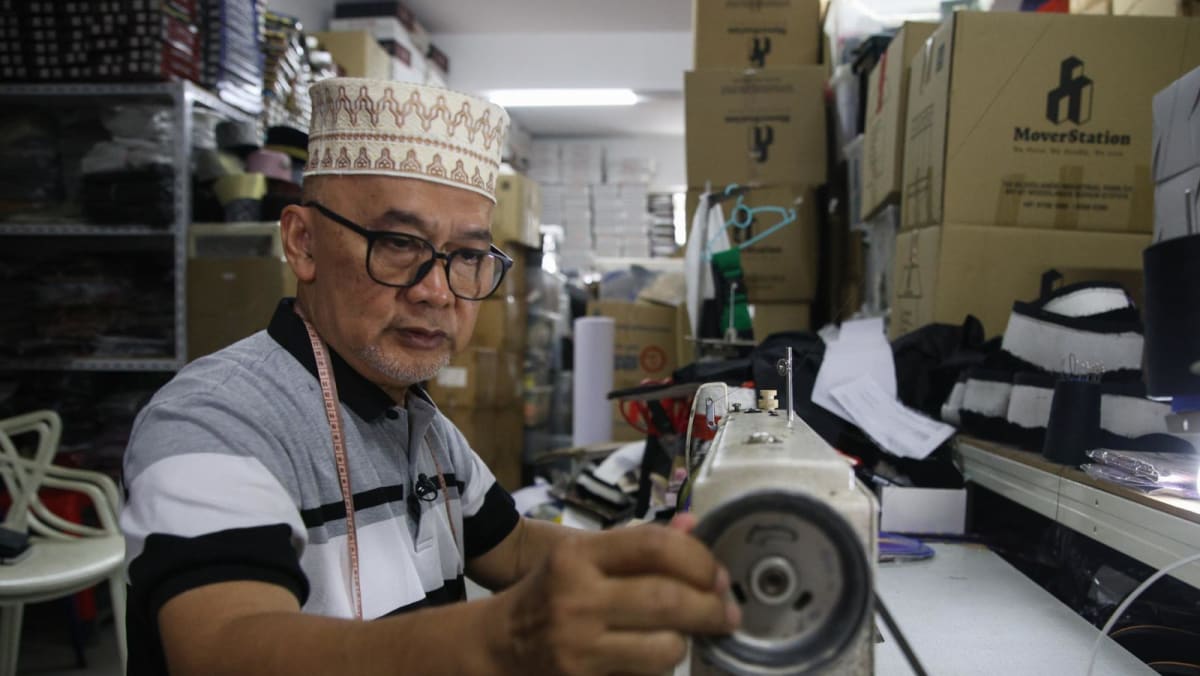HEADGEAR FOR FAMILIES AND ROYALTY
Mr Abdul Wahab has known no other way of earning a living other than entrepreneurship. He also helped to run his mother’s hawker stall in Chai Chee.
It was not that he had avoided taking up other jobs.
After finishing his full-time National Service, he asked his father’s blessings to stop working at the songkok store and to seek work elsewhere. Instead, he was handed an ultimatum.
“He told me, ‘If you choose to work outside, don’t step foot in this shop ever again’.”
It sounded harsh, but his father later explained that he did not want his son “to be stepped on” by employers and be subjected to the harsh working conditions he had faced.
“He told me, ‘You don’t know what it’s like working outside, I do. I don’t want you to be like me’.”
Mr Abdul Wahab did not take his father’s response badly. He told me that he had always been interested in continuing his father’s legacy and that episode merely nudged him more strongly down that path.
“I knew that I really wanted his knowledge (in the craft). Knowledge cannot be bought or traded. It can only be learned from a teacher.”
Back in the 1960s, there were quite a number of songkok makers, Mr Abdul Wahab said. “But most of the time, their children did not learn the skills from them.
“I had resolved that one day, I would take over from my father.”
Since then, he has never looked back.
When he had a shop, Mr Abdul Wahab would sew about 2,000 pieces of songkok on average a year, he said.
The peak period would be during the month of Ramadan, when people order the traditional headgear to wear for Hari Raya Aidilfitri.
“This receipt booklet has 100 pages. During Ramadan, I’ll finish two booklets,” he said, pointing to a booklet of handwritten receipts next to his industrial-grade sewing machine.
“And each page might not be just one person’s order, it’s for the family. So one receipt may have two, three or maybe four songkok orders.”
Outside of the festive seasons, Mr Abdul Wahab also receives orders for special occasions such as weddings.
He recalled getting a call from a customer a few years ago just as he was about to close his shop for the day at Tanjong Katong Complex. The customer, who was from Chua Chu Kang, told him to wait because he really wanted to make a songkok urgently.
“As it turned out, he told me that he had ordered a custom songkok from me in the 1990s at my shop in Geylang Serai market. Now, it was his son’s turn to get married so as the father of the groom, he wanted to look sharp and make a new one.”
Another memorable episode happened in his early years at Tanjong Katong Complex.
“A customer walked in and ordered a songkok on behalf of a member of a royal family in Kalimantan,” he said.
When I asked if he felt nervous then, he replied: “Nah, I’ve been doing this for years already.”
He admitted, though, that business was a lot more brisk when he had retail space in a shopping complex, where customers may also buy his ready-made songkok – either those that he had sewn himself or that he imported from Indonesia for the more budget-conscious.
He sells the songkok he imports for about S$20. His hand-sewn ones go for upwards of S$60.
Besides the lack of foot traffic, online competition as well as the growing number of Singaporeans who shop in Malaysia for their festive needs have caused a dent in his business, too.
A few years ago, his youngest son began helping him market his business online through his own website and on social media accounts. This has brought him a steady flow of customers, albeit fewer than in the years before.
“Back then, it was the older shoppers of Tanjong Katong Complex who would take their family to my shop,” he said.
“These days, it’s more of the younger generation who searched online, found my warehouse address and brought their family along.”
When CNA TODAY met him on the first weekend of Ramadan, he had an average of three or four appointments with customers daily.
And each year, more orders will come in as Hari Raya Aidilfitri draws nearer.
As I was writing this piece, Mr Abdul Wahab had already stopped taking new orders for this Hari Raya, which falls on March 31.
